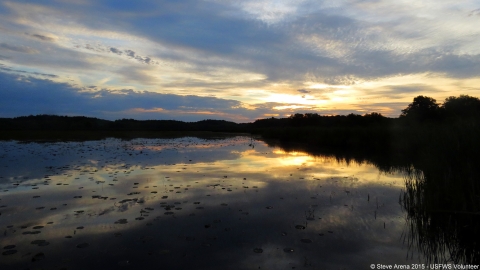About Us
Great Meadows National Wildlife Refuge, one of the eight refuges that make up the Eastern Massachusetts National Wildlife Refuge Complex, is broken into several units with two main units- the Sudbury unit and the Concord unit. Prior to colonization, the land that Great Meadows NWR is on was inhabited by Indigenous peoples including the Nipmuc, Pawtucket, Wampanoag and Susquehanna tribes. The river meadows and plains were burned to provide cropland and pasture for game, and the plentiful waters provided fish used as both food and fertilizer. In 1944, a local hunter, Samuel Hoar, donated over 200 acres of land to the U.S. Fish and Wildlife Service, establishing the refuge in Concord. The Sudbury unit was established later when the Service began buying additional land in the area to preserve vulnerable freshwater wetlands along the river.
Roughly 85% of the refuge is composed of valuable freshwater wetlands along the Sudbury and Concord Rivers. The goal of refuge management is to provide habitat for native fish and wildlife, especially migratory birds and Blanding's turtle, which are a threatened species in the state of Massachusetts. The refuge’s wetlands, fields and woods provide great habitat for many species, including birds, white-tailed deer, beaver, muskrat, otter, amphibians, and reptiles including many species of turtles.
Our Mission
Vision
The Eastern Massachusetts National Wildlife Refuge Complex will contribute to the mission of the Refuge System and support ecosystem–wide priority wildlife and natural communities. Management will maximize the diversity and abundance of fish and wildlife with emphasis on threatened and endangered species, migratory birds, and aquatic resources.
The Complex will have a well-funded and community supported acquisition program which contributes to wildlife conservation. The refuges will be well known nationally and appreciated in their communities. They will be seen as active partners in their communities, school systems, and environmental organizations which will result in high levels of support for the refuges.
The refuges will be a showcase for sound wildlife management techniques and will offer top-quality, compatible, wildlife dependent recreational activities. Refuges open to the public will provide staffed visitor contact facilities that are clean, attractive, and accessible, with effective environmental education and interpretation.
Refuge Purposes
Each unit of the National Wildlife Refuge System is established to serve a statutory purpose that targets the conservation of native species dependent on its lands and waters. All activities on those acres are reviewed for compatibility with this statutory purpose.
The purposes of Great Meadows National Wildlife Refuge is
“..for use as an inviolate sanctuary, or for any other management purpose, for migratory birds.” (16 U.S.C. § 715d),
“…suitable for –incidental fish and wildlife-oriented recreational development, “(16 U.S.C. § 460k-1),
“the protection of natural resources,” (16 U.S.C. § 460K-1)
“and the conservation of threatened or endangered species...” (16 U.S.C. § 460K-1)
Our History
Prior to colonization: This region's first peoples called knew the place we call Concord today as Musketaquid. In the Algonquian language, the name means "grassy river" or "grassy island". Archeological evidence shows that humans have lived in this region going back as far as 12,000 years ago. The Indigenous peoples who were present in this region include the Nipmuc, Pawtucket, Wampanoag, Susquehanna tribes.
1620s: British colonists arrive to this region, first building towns along the coast. The highly lucrative fur trade brought some English settlers further inland.
1928: A hunter named Samuel Hoar purchased a piece of land along the Concord River and built dams and dikes to hold the water in the marshes, enhancing their value as waterfowl habitat.
1944: Samuel Hoar donates 250 acres of this land to the U.S. Fish and Wildlife Service, creating Great Meadows National Wildlife Refuge; Concord Unit
1960s: U.S. Fish and Wildlife Service buy additional land, adding new parcels and units to Great Meadows NWR.
Other Facilities in this Complex
Situated along the Atlantic Flyway in Massachusetts, the Eastern Massachusetts National Wildlife Refuge Complex is comprised of eight ecologically diverse refuges. The eight individual refuges include inland and coastal wetlands, forests, grasslands, and barrier beaches that provide important habitat for migratory birds, mammals, plants, reptiles and amphibians.
Complex headquarters is located at Assabet River National Wildlife Refuge, 680 Hudson Road, Sudbury, MA, 01776. Phone: (978) 562-3527.





